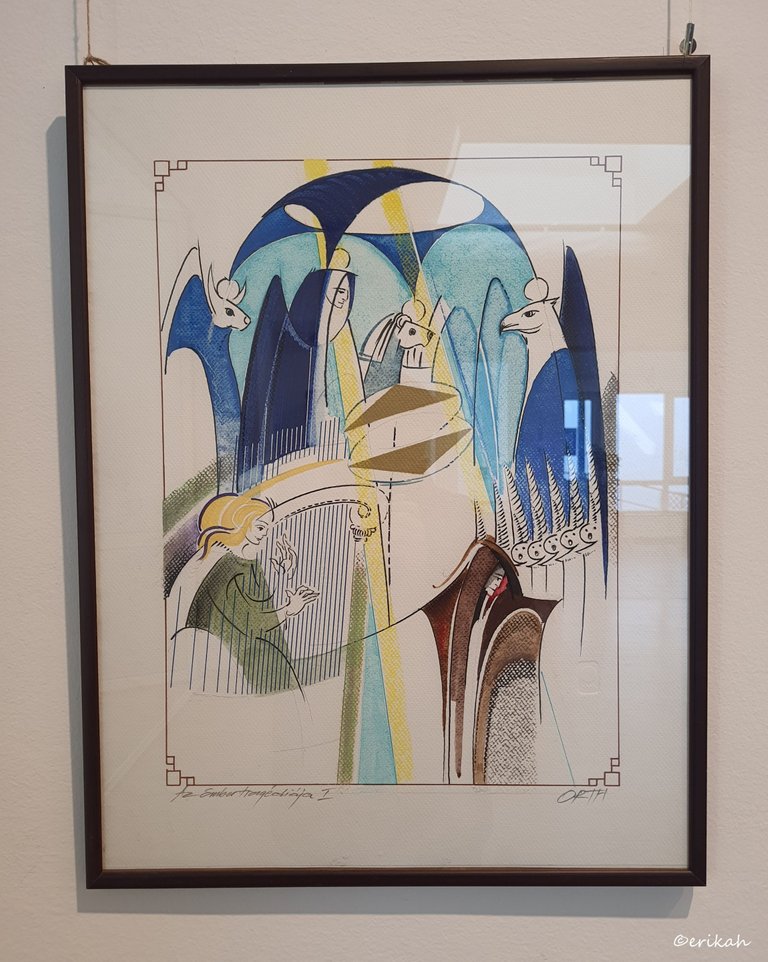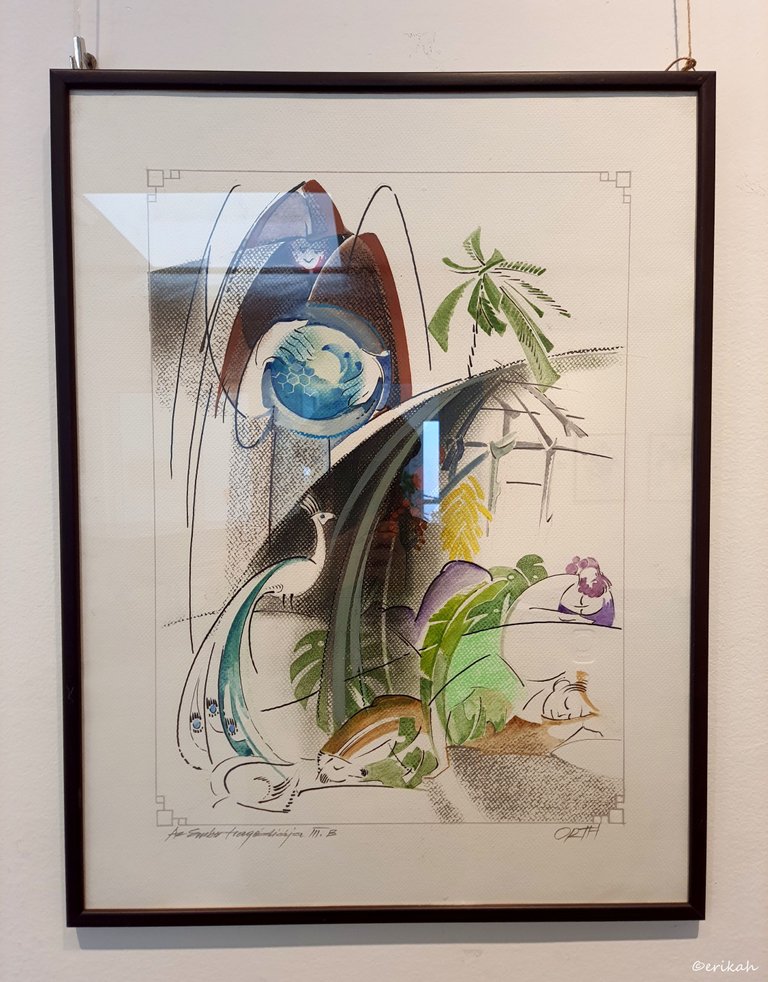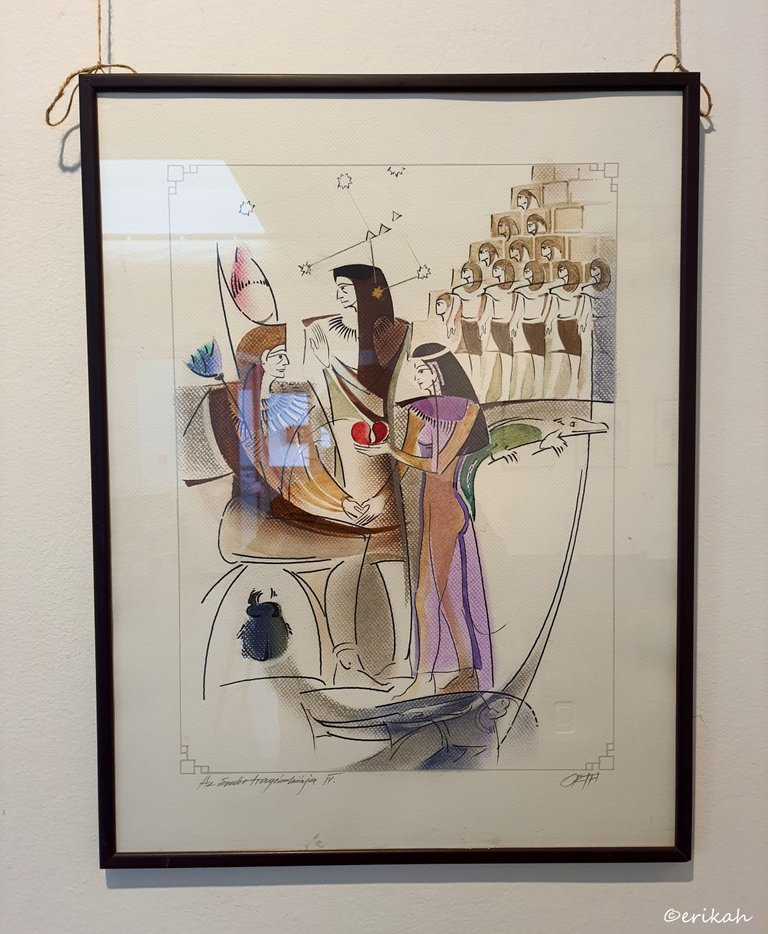Today I went to visit another exhibition, which I must admit, surprised me a lot. I knew what to expect as I've read what was the exhibition about, but what I saw was absolutely exceptional. While I was admiring the artworks, was thinking how lucky I am to be able to witness such beauty, for free.
When I came home, I spoke to a friend and told him I went to visit another art exhibition.
You live a boring life as that is not my idea of fun.
This is what he said 😂. This makes me a weirdo as it seems I don't know what fun is. He made me laugh as these exhibitions are a lot of fun for me and they motivate me to start creating art.

In 2023 we're celebrating 200 years from the birth of Imre Madách, the author of the play. Portrait of Imre Madách on the right in the photo above. This series was created to celebrate the author.
The Tragedy of Man (Hungarian: Az ember tragédiája) is a play written by the Hungarian author Imre Madách. It was first published in 1861. The play is considered to be one of the major works of Hungarian literature and is one of the most often staged Hungarian plays today. Many lines have become common quotations in Hungary. The 1984 film The Annunciation (Angyali üdvözlet) was based on the play, as was the 2011 animated film The Tragedy of Man. source
It's a very interesting play. You can read the Synopsis here.


The Tragedy of Man contains fifteen scenes, with ten historical periods represented. source
The author of the artworks, István Orth, respected this setup, although there were more than 15 artworks as some of the scenes had two artworks.
Below each artwork, I'm going to post the name of the scene, which I'm copying from Wikipedia

In Heaven, immediately following the creation.
This was the first artwork I saw and it fascinated me right away. Each artwork was ink and watercolor on paper. The simplicity of the works is what I loved the most, I think. Look at this one. Just a few lines, without abundant details, some colors and that is all.

In the Garden of Eden at the Beginning of Human History, likely around 75,000 BC.
Before visiting the exhibition I was thinking I should, at some point try to do some graphic arts, that have always been my dream but I've never considered myself brave enough to try it out. Then I see these wonderful artworks.
So what I did as get close to each of them and observe every detail. I suppose that's how you learn. What I was able to figure out here was that first, the artist made a drawing, most likely a ruler was used and the texture you see is due to the paper. There will be close-up photos later, where you can see the paper from close.


Outside the Garden of Eden at the Beginning of Human History
Now look at the painting and read the title. Can you see, what the title says, in the painting?

Egypt, c. 2686-2648 BC. Adam is a Pharaoh, most likely Djoser; Lucifer his Vizier Imhotep; Eve is the widow of a slave

Athens, 490-489 BC. Adam is Miltiades the Younger; Lucifer is a city guard; Eve is Miltiades' wife


Rome, c. 67 AD. Adam is a wealthy Roman; Lucifer is his friend, Eve is a prostitute

Here's a close-up photo for you to see the details. I'm not sure how the artist managed to create those shades with watercolor, but I find it very interesting.



Constantinople, 1096-1099 AD. Adam is Tancred, Prince of Galilee; Lucifer is his squire; Eve is a noble maiden forced to become a nun
I'm not a religious person, so hanging religious scenes on my wall is not a priority, but this one looked amazing.

This one belongs to the previous one. Painting the people so tall was an excellent idea. I loved this one as well. Another detail that I need to mention is that the white background, accompanied by just a handful of colors was a good choice.
For the first time in my life, I walked past the artwork twice, I mean I had to look at each one another time. Thankfully it was only one room and about 20 paintings, but it was worth it. I think this series inspired me a lot. Let's hope the inspiration is strong enough to hold till I get time to try something. In the near future I should by this special paper and some ink though.

If you're a newbie, you may want to check out these guides:
- Communities Explained - Newbie Guide
- Cross Posting And Reposting Explained, Using PeakD
- Hive Is Not For Me
- How To Pump Your Reputation Fast - Newbie Guide
- Tips And Tricks & Useful Hive Tools For Newbies
- Community List And Why It Is Important To Post In The Right Community

This is a fantastic series and an incredibly creative artist! I can tell they are using UV-Resistant Non-Glare Museum Glass on those frames from the looks of it. I could be wrong, but did it seem like less of a glare in person to your eyes than appears in some of the photos? If so, then it's most likely Museum quality glass, which can almost give the art an HD effect when you examine up close.
That image shows the HD effect on the close-up areas but that glare has a tint to it that is either the natural lighting or the glare only that kind of glass gives off. It's non-glare, but that is in comparison with regular untreated or regular UV coated glass. It still has a glare but only when light hits it at certain angles. If you get creative with your angles of shooting... you can always find an angle to bypass the glare. But, that's an art in and of itself! hahahhaa Cheers!
It was indeed a fantastic series and I'm glad you find it interesting.
You may be right about the glass, but there's no way to know for certain. This is a foundation and not a museum, so the exhibitions are coming one after another, I think every two weeks there's a new one. This means they are displaying what they are getting from the artists, who are using whatever glass they want or can afford.
This series however is different as all the pieces were framed the same time, with the same glass and as the series is traveling from museum to museum, it's possible the artist opted for quality.
I agree with that and trust me, have been doing it as there's not other option, that's why my photos are taken from strange angles. However, in this case my best option was what I did, take the photo facing the artwork, or at least that was my decision. I have a plan for the future. I was able to figure out that if I close the front doors, will be able to eliminate the light coming from outside. I need permission to do that, but as there are not many people visiting at that hour, I don't think they will mind. Let's see what I can do with closed doors.
Now that you are here, I'd like to ask your opinion about how these paintings were created. Is it watercolor and ink as I am suspecting? What can you tell me about it? Would appreciate your opinion.
It's beautiful art, I really like to see art in the eden garden where the beginning of the history of human civilization, waw is amazing
It was indeed amazing, I liked it a lot.
Sorry to comment on a side topic and not on the main one... but, láttad a zongorát a sarokban? 😁
🎹
Lol, ezt a zongirát mutattam már. Te is írtál róla 😀
I don't know about paintings, I'm just a connoisseur. But given the history and longevity of the paintings, there is one small part that I noticed looks the same: the frame on each painting. The pattern looks the same, and it seems as if the pattern predates the painting inside, or because of the high quality of the painting inside, it does not come out. I'm just guessing, please forgive me. Blessing
Most likely the frames were ordered the same time, which makes sense as this is a series.
What I mean about the same frame format is that the one inside, I don't know what it's called. it's definitely not the black frame outside. .
That's part of the design.
Very nice paintings, beautiful exhibition👏🏻👏🏻👏🏻
Thank you
Nice post and nice presentation.
Thanks for sharing.
Nice art work.
Greetings
Thank you.
@erikah, one of your Hive friends wishes you a Happy Valentine's day and asked us to give you a new badge!
To find out who wanted you to receive this special gift, click here!
You can view your badges on your board and compare yourself to others in the Ranking
Check out our last posts: